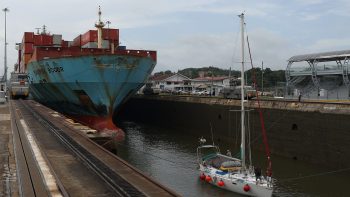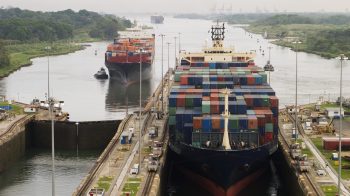Expanding the Panama Canal
TEXT OF INTERVIEW
LISA NAPOLI: This weekend, the people of the poor nation of Panama vote on whether to modernize its critical but antiquated canal. The Panama Canal expansion project would cost more than $5 billion, a third of the country’s gross domestic product. But Panama’s government says bolstering the canal is the only way to fight poverty, which is at 60 percent. Lucy Conger is a correspondent for Institutional Investor and she’s in Panama to cover the vote. She says the canal is critical to world trade.
LUCY CONGER: The new set of locks that is proposed by the canal would be about 80 feet wider and they would also be about 200 feet longer. And so that would allow these giant container ships that carry as many as 10,000 containers to get through the new canal.
NAPOLI: How would the expansion project trickle down to the people of Panama?
CONGER: That’s a question that quite a lot of Panamanians have in mind and because they feel that previous governments haven’t done enough for the poor, they’re asking themselves ‘why should I believe now that this project is going to help the poor?’ The government a couple of years ago launched a plan to dedicate a certain percentage of the revenues on ships going through the canal to poverty programs, particularly education and health.
NAPOLI: Lucy, what would a wider Canal mean for trade between China and the United States?
CONGER: A wider Canal is going to mean that the growing trade between China and the United States could be shipped on wider vessels. The largest ship that can go through the Panama Canal carries about 4,400 containers. With this wider lane, you’d be able to have container vessels that carry 8,000 and up to 12,000 containers. A wider Canal is more efficient and less expensive than using a route such as going to Long Beach in California, unloading containers, putting them on trains, shipping them across the States and then unloading them again somewhere.
NAPOLI: What is it that’s moving through the Canal? What kind of goods?
CONGER: The main goods that come from China to the United States are electronics, apparel including sports clothing, auto parts, furniture, toys and kitchen equipment. And the main item shipped from the United States to China is soybeans.
NAPOLI: Lucy, what’s the mood in Panama right now?
CONGER: Most Panamanians feel that the Canal is absolutely vital to their country. They’re not sure that this project has to be done now. There are some doubts about whether this project has been debated adequately, and there is concern that the cost of the project might get out of control and end up adding to Panama’s national debt. On Sunday, they’ll have the last word.
NAPOLI: Lucy Conger’s a correspondent with Institutional Investor. In Los Angeles, I’m Lisa Napoli. Enjoy your weekend!
There’s a lot happening in the world. Through it all, Marketplace is here for you.
You rely on Marketplace to break down the world’s events and tell you how it affects you in a fact-based, approachable way. We rely on your financial support to keep making that possible.
Your donation today powers the independent journalism that you rely on. For just $5/month, you can help sustain Marketplace so we can keep reporting on the things that matter to you.


















